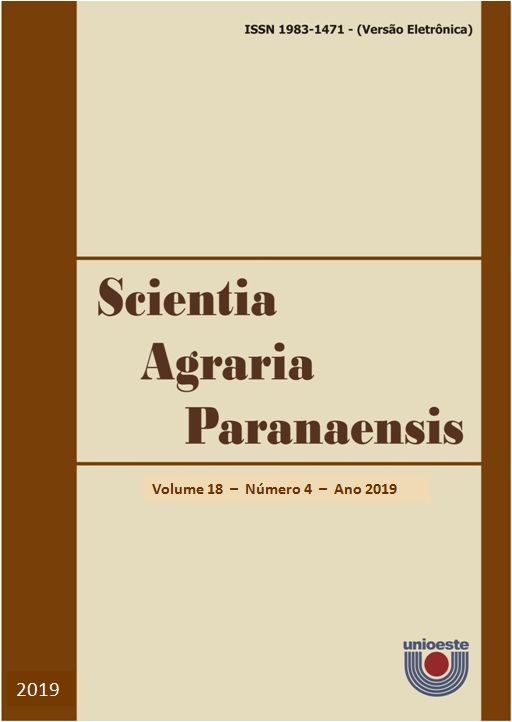Soil tillage to produce cassava roots with less physical limitations in pasture succession
DOI:
https://doi.org/10.18188/sap.v18i4.23433Resumo
Traditional cassava cultivation involves mechanical manipulation of the soil with one plowing and two harrowings, a practice that may generate problems such as soil erosion, compaction and nutrient loss. These issues may be even bigger in sandy soils. The objective of this study was to evaluate the cassava roots components and the soil physical attributes in planting rows and between planting rows in tillage systems substituting the conventional tillage before the Mombasa grass pasture (Panicum maximum), in Northwestern Paraná, Brazil. Soil tillage treatments in 2014 were carried out as follows: conventional (disc harrow, moldboard plow and disking), minimum (disc harrow and chisel plow - clod breaking) and zero tillage. In 2015, soil samples were collected in layers 0.0-0.1, 0.1-0.2 and 0.2-0.4 m deep, between, and within cassava planting rows, for soil bulk density and macroporosity determinations. Number of plants, number of tuberous roots per plant, fresh and dry mass of cassava tuberous roots were evaluated as well. The soil physical attributes within the planting rows negatively affected the production of cassava tuberous roots in zero tillage in succession to the Mombasa grass pasture. The minimum and conventional tillage systems did not present soil physical limitations to the cassava yield components in succession to Mombasa grass pasture. Minimum tillage may be an alternative to conventional tillage without compromising soil physical attributes and cassava root yield in the Mombasa pastureland reform areas, in northwestern Paraná.
Downloads
Publicado
Como Citar
Edição
Seção
Licença
Aviso de Direito Autoral Creative Commons
Política para Periódicos de Acesso Livre
Autores que publicam nesta revista concordam com os seguintes termos:
1. Autores mantém os direitos autorais e concedem à revista o direito de primeira publicação, com o trabalho simultaneamente licenciado sob a Licença Creative Commons Attribution que permite o compartilhamento do trabalho com reconhecimento da autoria e publicação inicial nesta revista.2. Autores têm autorização para assumir contratos adicionais separadamente, para distribuição não-exclusiva da versão do trabalho publicada nesta revista (ex.: publicar em repositório institucional ou como capítulo de livro), com reconhecimento de autoria e publicação inicial nesta revista.
3. Autores têm permissão e são estimulados a publicar e distribuir seu trabalho online (ex.: em repositórios institucionais ou na sua página pessoal) a qualquer ponto antes ou durante o processo editorial, já que isso pode gerar alterações produtivas, bem como aumentar o impacto e a citação do trabalho publicado (Veja O Efeito do Acesso Livre).
Licença Creative Commons
Esta obra está licenciada com uma Licença Creative Commons Atribuição-NãoComercial-CompartilhaIgual 4.0 Internacional, o que permite compartilhar, copiar, distribuir, exibir, reproduzir, a totalidade ou partes desde que não tenha objetivo comercial e sejam citados os autores e a fonte.


